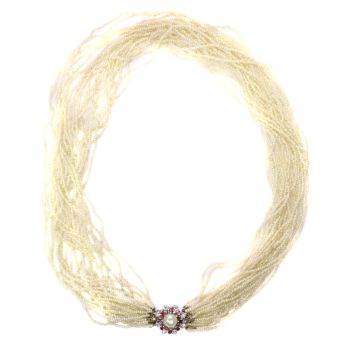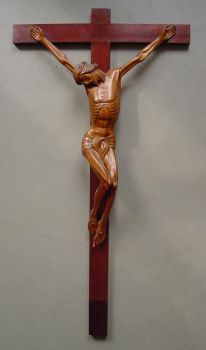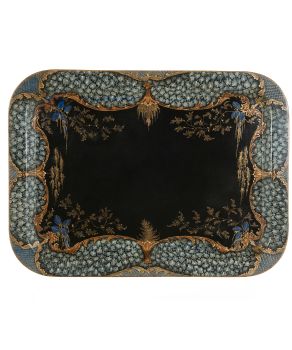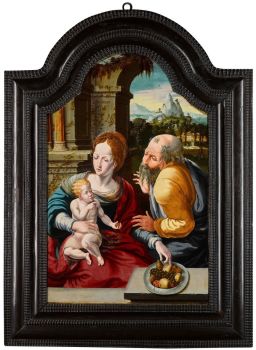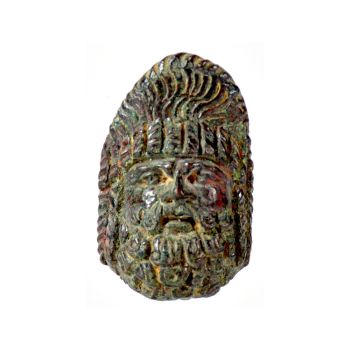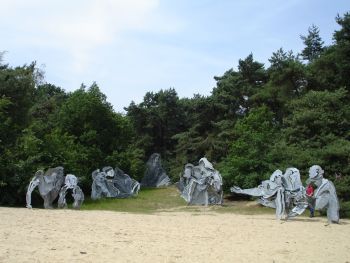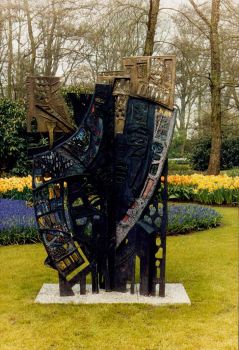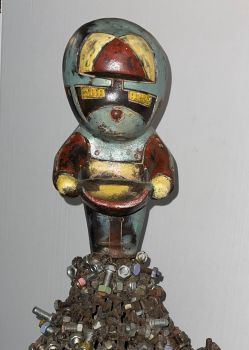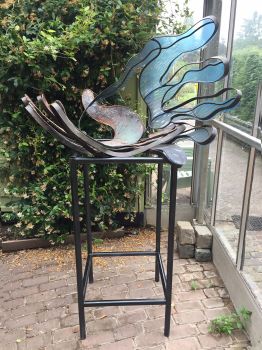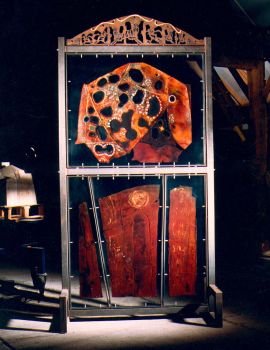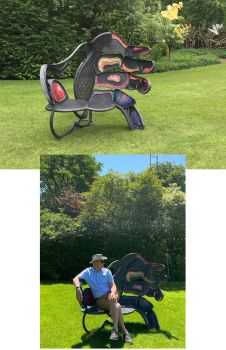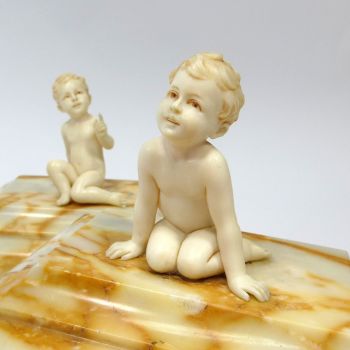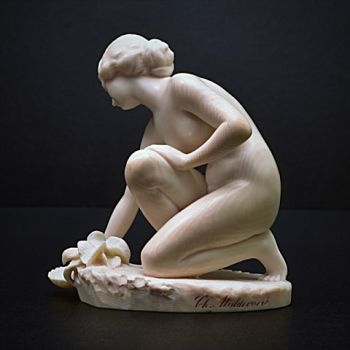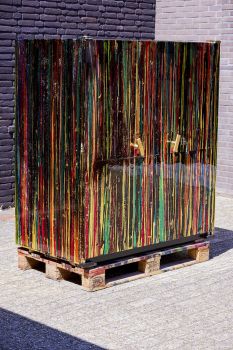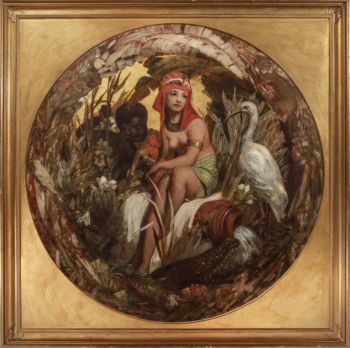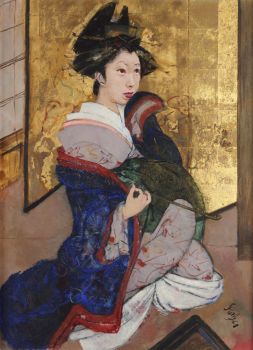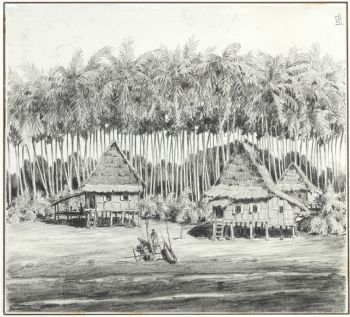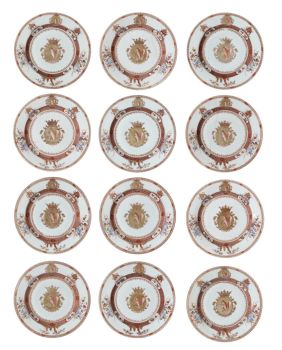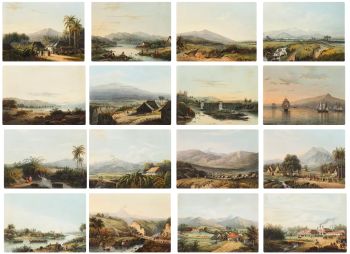A superb inlaid walrus ivory and blue glass Ottoman knife 1700
Onbekende Kunstenaar
BeenGlasStaalIvoorMetaal
Prijs op aanvraag
Zebregs & Röell - Fine Art - Antiques
- Over kunstwerkA superb inlaid walrus ivory and blue glass Ottoman knife
Ottoman Empire, Turkey, probably Constantinople (Istanbul), late 17th/early 18th-century
The hilt is formed of a faceted blue glass, while the blade of steel exhibits faux-watering and is inset with beads of coral at three equidistant slots just beneath the spine. The surface of the blade has also been etched over the greater part of its length with an inscription on one face with a part of the Nada ‘Ali quatrain and on the other with “… Muluk (?) sultan malik tahir (?)” (“… of Kings (?), Sultan Malik Tahir (?)”) among vine tendrils that exhibit remnants of the original gilding. Gilt stellar motifs also line the spine of the blade.
The scabbard is inset with a generous array of khatamkari roundels depicting celestial motifs with gems, mother-of-pearl and various metals. Of particular splendour are the ebony tesserae, which are overlaid with pointed stars in gold, some of the larger examples decorated at their centres with an inset turquoise or gold concentric circles. The craftsman has expended great efforts to ensure almost no space is left unfilled, inviting the spectator to inspect the scabbard’s surface as one might survey a busy night-sky. It is interesting to note, too, that the central roundel of the front face is decorated on a shimmering white ground in mother-of-pearl, whilst that on the reverse is black (ebony), as if the front and reverse of the scabbard signified the day and night skies respectively. The scabbard’s gilt-silver collar and chape are punched and chased to depict stylised leaves and roundels in imitation of the scabbard’s central surface, and are further inset with small turquoises as well as coloured gem stones, the chape terminating in a cross-hatched acorn finial.
L. 19.7 cm
Provenance:
With Runjeet Singh, London
This remarkable knife brilliantly exemplifies the artistry so often applied to exceptional pieces of arms and armour, its scabbard proficiently decorated throughout with roundels in a dazzling array of colours and patterns.
Remarkably, the side of the scabbard shows a zig-zag motif, to some immediately recognizable from Japanese Namban export lacquer ordered by the Portuguese. This lacquerware was not intended for the Portuguese market only and was often given as diplomatic gifts to different courts – also to the Ottoman court. The resemblance is so uncanny that it is tempting to suggest that the craftsman took inspiration from such a piece. After all, it is widely known that at the Ottoman court, too, Chinoiserie was in fashion.
A very comparable knife and scabbard can be found in the Schatzkammer of the Bavarian Palace in Munich (inv.no. 1235 or 1819/20). It probably entered the collection through the Pfälzer Wittelsbacher line, who in the 16th and 17th century were known to collect Ottoman artefacts as Turquerie, also known as Turkomania, was in vogue.
A miniature sword in the Walters Art Museum (access.no. 51.79) exhibits a similar sequence of insets along the back-edge of its blade. - Over kunstenaar
Het kan voorkomen dat een kunstenaar of maker onbekend is.
Voor sommige werken is het niet te bepalen door wie het gemaakt is of dat het is gemaakt door (een groep) ambachtslieden. Voorbeelden zijn beelden uit de Oudheid, meubels, spiegels of handtekeningen die vaak niet duidelijk of leesbaar zijn. Maar ook sommige werken zijn helemaal niet gesigneerd.
Ook kunt u de volgende beschrijving vinden:
•"Toegeschreven aan …." waarschijnlijk een werk van de kunstenaar maar niet zeker of gedeeltelijk
•“Atelier van ….” of werkplaats van” een werk uitgevoerd in het atelier of atelier van de kunstenaar, eventueel onder zijn toezicht
•“Cirkel van ….” een werk uit de periode van de kunstenaar die zijn invloed laat zien, nauw verbonden met de kunstenaar maar niet noodzakelijkerwijs zijn leerling
•“Stijl van ….” of “Volger van ….” een werk uitgevoerd in de stijl van de kunstenaar, maar niet noodzakelijk door een leerling; kan eigentijds of bijna eigentijds zijn
•“Wijze van ….” een werk in de stijl van de kunstenaar maar van latere datum
•"Na …." een kopie (van welke datum dan ook) van een werk van de kunstenaar
•“Getekend…”, “Gedateerd….” of “Ingeschreven” dan is het werk gesigneerd/ gedateerd/ ingeschreven door de kunstenaar. De toevoeging van een vraagteken duidt op een element van twijfel
•"Met handtekening ...", "Met datum ...", "Met opschrift..." of “Draagt signatuur/datum/opschrift” dan is de handtekening/datum/opschrift toegevoegd door iemand anders dan de kunstenaar
Bent u geïnteresseerd om dit kunstwerk te kopen?
Related artworks
- 1 - 4 / 12
Onbekende Kunstenaar
A RARE LARGE JAPANESE LACQUERED LEATHER TELESCOPE1750 - 1800
Prijs op aanvraagZebregs & Röell - Fine Art - Antiques
Onbekende Kunstenaar
A Japanese bronze Hu flower vase, Edo / Meiji, 19th century19th century
Prijs op aanvraagMenken Works of Art
Onbekende Kunstenaar
The Stamford Raffles Secretaires.1800 - 1813
Prijs op aanvraagZebregs & Röell - Fine Art - Antiques
Onbekende Kunstenaar
Indian colonial inlaid work box, 18th century1700 - 1750
Prijs op aanvraagVerkoulen Oriental & European Antiques
Onbekende Kunstenaar
EEN JAPANS MODEL VAN EEN NORIMONO, EEN DRAAGSTOEL1650 - 1700
Prijs op aanvraagZebregs & Röell - Fine Art - Antiques
Onbekende Kunstenaar
EEN COLLECTIE VAN VIER SRI LANKAANSE IVOREN BIJBEL DOZEN18th century
Prijs op aanvraagZebregs & Röell - Fine Art - Antiques
Onbekende Kunstenaar
A SMALL IVORY NETSUKE OF A DUTCHMAN WITH A DRUM1750 - 1800
Prijs op aanvraagZebregs & Röell - Fine Art - Antiques
Onbekende Kunstenaar
EEN VERGULD-ZILVER SRI LANKAANSE DOCUMENTEN ROLCONTAINER19th century
Prijs op aanvraagZebregs & Röell - Fine Art - Antiques
Onbekende Kunstenaar
AN IVORY NETSUKE OF A DUTCHMAN FROLICKING WITH A SMALL BOY18th century
Prijs op aanvraagZebregs & Röell - Fine Art - Antiques
Onbekende Kunstenaar
EEN IVOREN NETSUKE VAN EEN NEDERLANDER MET EEN HAAN18th century
Prijs op aanvraagZebregs & Röell - Fine Art - Antiques
1 - 4 / 24Onbekende Kunstenaar
EEN COLLECTIE VAN VIER SRI LANKAANSE IVOREN BIJBEL DOZEN18th century
Prijs op aanvraagZebregs & Röell - Fine Art - Antiques
Onbekende Kunstenaar
A SMALL IVORY NETSUKE OF A DUTCHMAN WITH A DRUM1750 - 1800
Prijs op aanvraagZebregs & Röell - Fine Art - Antiques
Onbekende Kunstenaar
Indian colonial inlaid work box, 18th century1700 - 1750
Prijs op aanvraagVerkoulen Oriental & European Antiques
1 - 4 / 24Onbekende Kunstenaar
EEN JAPANSE KLEINE SAWASA 'PERZIK-VORMIGE' KROESKOPearly 18th
Prijs op aanvraagZebregs & Röell - Fine Art - Antiques
Onbekende Kunstenaar
EEN HOOFDTOOI VAN VEREN VAN DE JURUNA-STAM1900 - 1950
Prijs op aanvraagZebregs & Röell - Fine Art - Antiques
Abraham Salm
Twenty-four chromolithographs of Java after A. Salm”1801 - 1876
Prijs op aanvraagZebregs & Röell - Fine Art - Antiques
Onbekende Kunstenaar
The bell of the VOC fortress in Jaffna, Sri Lanka1747
Prijs op aanvraagZebregs & Röell - Fine Art - Antiques
 Gecureerd door
Gecureerd doorDanny Bree
1 - 4 / 12






